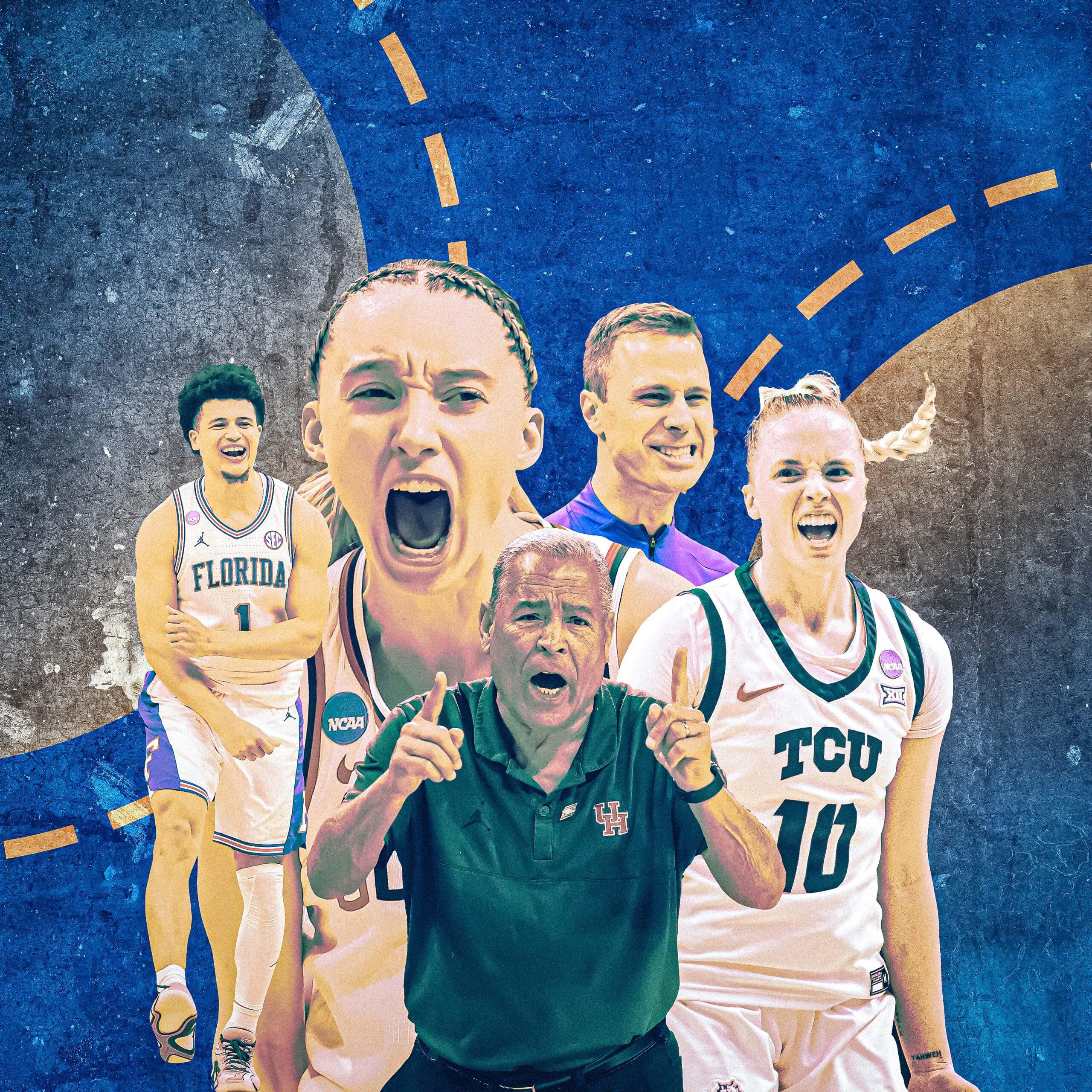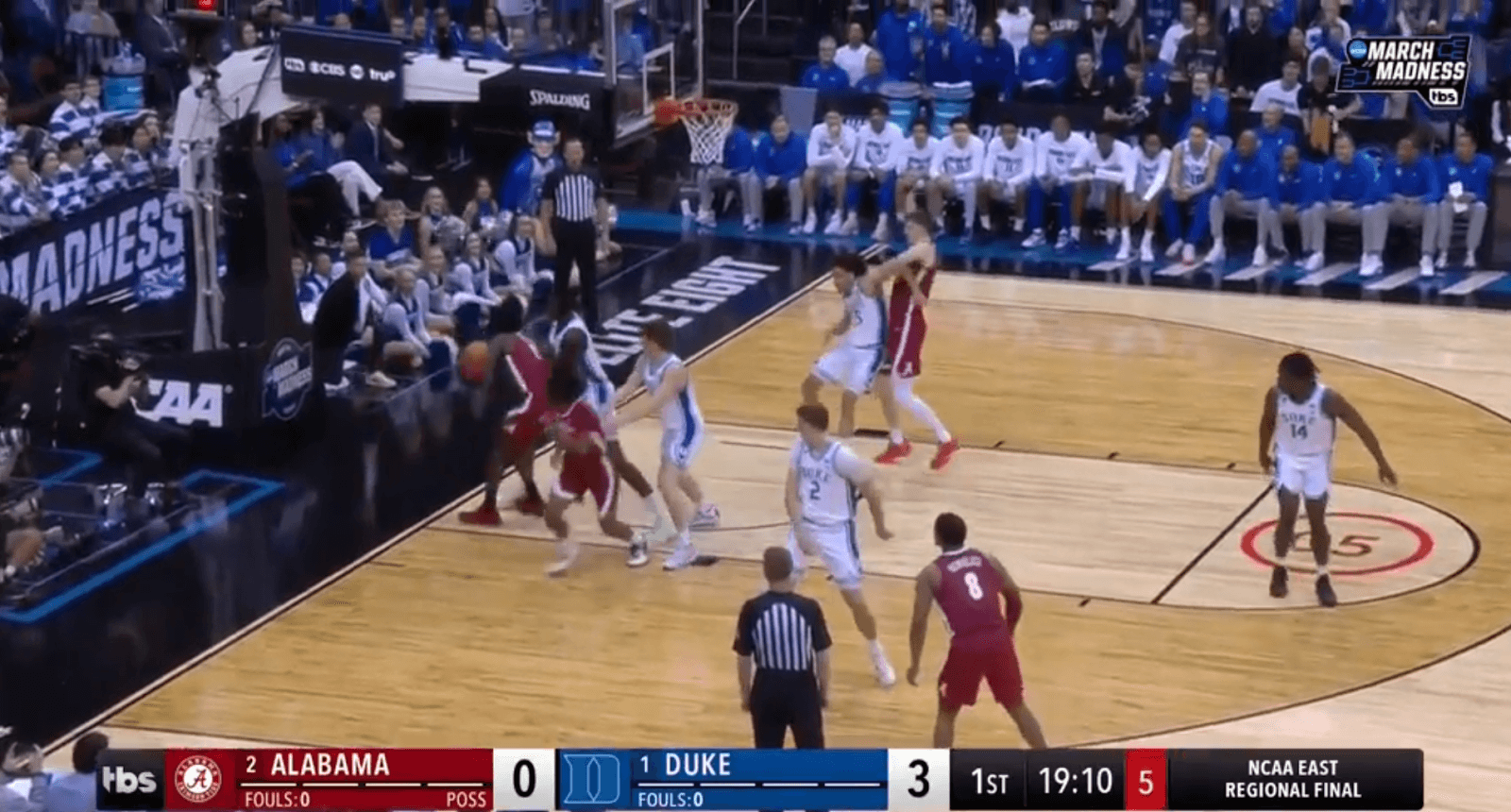The Winners and Losers of the Sweet 16 and Elite Eight
Chalk reigns, Paige Bueckers and UConn are our only non-1-seed hope, and Jon Scheyer and Duke keep marching on
Who shined brightest in March Madness’s Sweet 16 and Elite Eight? Who fell short? Let’s dive into a special edition of Winners and Losers.
Winner: Kelvin Sampson
Over the first three rounds of the NCAA tournament, Houston looked like a team playing with the weight of failed expectations on its back. The top seed in the Midwest region was sluggish against SIU Edwardsville in the first round, disorganized in a close call against Gonzaga in the second round, and lost at times against Purdue in the Sweet 16—the round where Houston’s last two seasons came to an end. Purdue coach Matt Painter had the Boilermakers ready for Houston’s unique defensive pressure. Point guard Braden Smith had no issues, racking up 15 assists against only three turnovers. And Painter set up his secondary scoring options—Fletcher Loyer and Cam Heide—for big games. Purdue seemed to have a counter for every punch Houston threw, up until the knockout blow.
Sampson threw that final punch himself. It came in a tied game with 2.8 seconds left on the clock. Houston was inbounding the ball right under its basket, so the coaching staff discussed a lob play for big man Joseph Tugler that could work against a small Purdue lineup. Sampson instead pulled rank and instructed his team to run “51,” the first inbound play Sampson installs each season. The goal was to free LJ Cryer for an open jump shot near the baseline. Smith left the inbounder, Milos Uzan, to cover up Cryer, which Sampson had anticipated after seeing Smith do that same thing on tape. Uzan threw the inbound to Tugler, who instinctively threw it right back to a wide-open Uzan under the basket. Game over.
Sampson picked up the play during his time working under Scott Skiles as an NBA assistant. But he says in all his years deploying it, he had never seen it work out like it did against Purdue—with the inbounder getting the ball back for a layup. He made sure Uzan was ready for the moment just in case. “Don’t be a neutral observer and stand out of bounds and wonder what Jo’s going to do,” Sampson said after the game. “Make sure you get both feet in bounds so that when you catch it, it will be legal.”
Uzan followed his coach’s instruction, and it led him to the easiest game-winning shot he’ll probably ever hit.
No game-winning shots were required against Tennessee. The Cougars team finally resembled the powerhouse it was the rest of the season in its 69-50 Elite Eight win. But if Sampson is going to make it to his first national title appearance this season, he’ll need every bit of his coaching prowess with Duke waiting in the semis.
Loser: The Pressure of Following a Legend
The major downside of taking the Duke job right after Mike Krzyzewski is the inevitable comparison to the legendary coach. But three seasons in, Jon Scheyer should be inviting those comparisons. Coach K hadn’t made an NCAA tournament by the end of his third season in Durham—or in any of his five seasons as Army’s coach. His first tournament win didn’t come until his fifth season with the Blue Devils. Meanwhile, Scheyer is headed for the Final Four, and his Duke team is the heavy favorite to cut down the nets in San Antonio after an 85-65 win over Alabama in the East regional final. Before taking over the job, Scheyer said he wasn’t afraid of “being the guy that follows the guy,” despite the warnings he'd heard.
“When you look at successions, very rarely do people succeed … following a legendary or a great coach,” Scheyer said after clinching his first Final Four berth. “I’ll tell you, for me, a huge thing was having that year, though. For Coach K to be able to have the vision—I don’t know how many coaches genuinely want to see the program succeed when they leave.”
Scheyer was named Duke’s coach-in-waiting a few months before Krzyzewski’s farewell season, and he had a full year to prepare for the job. He took over the lead on the recruiting trail that summer, and he’d been promoted to associate head coach back in 2018, meaning he already had a hand in building the team’s strategy. So as significant as K’s retirement was for the college basketball landscape, there really wasn’t much of a transition for Duke’s program. And after two solid seasons, Scheyer has elevated the team to a national power once again by dominating on the recruiting trail and growing as a strategist. The 37-year-old has a dream roster—but he’s been putting it to good use, too.
The dominant win over Alabama was the latest example of Duke’s talent and smart coaching working in concert. The Blue Devils put up 85 points, but this game was won on the defensive end. Duke held Alabama to 0.9 points per possession—the Tide’s second-lowest mark of the season, per KenPom. Two nights after the SEC school lit up BYU for a tournament-record 25 3-pointers, Alabama’s shooters combined to make just eight on Saturday night. Scheyer’s plan seemed to revolve around Alabama’s three best 3-point shooters: Mark Sears, Aden Holloway, and Chris Youngblood. Scheyer instructed his defenders to switch on any screening actions, whether on the ball or away from it. And they also stuck tight to those three on the perimeter rather than helping out on drives. The goal was to make Alabama’s lesser shooters win the game. Labaron Philon, a 32 percent shooter from deep, and Aiden Sherrell, who had made 12 3-pointers all season entering the game, drained a few shots early, but Scheyer stuck with the plan, and it worked.
Throughout the season, Alabama got a lot of its 3-point shots off of drive-and-kicks after its guards got into the lane. But Duke’s length made it difficult to get into the paint all night. We got our first sign that that would be the case on the Tide’s first offensive possession of the game.
An Alabama player doesn’t get two feet down in the paint until there’s five seconds left on the shot clock—and he’s stuck behind the backboard!

That set the tone for the evening.
Now, Duke goes rolling into the men's Final Four with the nation’s best offense and a defense that just stuffed the country’s most prolific scoring attack in a locker. Scheyer has assembled a team worthy of a national title, and he’s just two wins away from securing the first one of his head coaching career in only his third season on the job. Coach K could never.
Winner: Paige Bueckers (and Strange Motivational Tactics)
As UConn entered the fourth quarter of its Sweet 16 matchup with Oklahoma, Paige Bueckers was already on her way to yet another strong performance in the NCAA tournament. She had 21 points, and the Huskies were in complete control of the game. But coach Geno Auriemma wanted more out of his star, which he made clear during an in-game interview with ESPN’s Holly Rowe.
“There’s times when she has the ball, and the defense, they know she’s not going to shoot it,” Auriemma said. “And I’m thinking, Shoot it! … Hopefully, in the fourth quarter, she just …”
Auriemma trailed off, but Bueckers sure didn’t. Over the next 10 minutes of game time, she poured in 19 consecutive points for the Huskies and outscored the Sooners all on her own. Oklahoma made the bold decision to play a “drop” coverage against UConn’s pick-and-rolls, which gave Bueckers the time and space to pull up for open jumpers off the bounce, and she punished the Sooners for a total of 40 points, a career high and a new program record in an NCAA tournament game.
“Paige was spectacular,” Auriemma said after the game. “That was as good a game as I’ve seen her play the whole time she’s been here, at the most important time.” A few moments later, Auriemma realized he had broken character and inadvertently praised the star he’s been trying to motivate. “Did I really say that, that that’s the best I’ve seen her play?” he asked, looking for a way to backtrack. “That came out of my mouth? Well, that’s the most I’ve seen her shoot, and she was really bad defensively, so we can’t just let her off the hook that easily.”
Auriemma might be Bueckers’s greatest hater—if only for effect. After she exited the game, the UConn coach sarcastically asked whether Bueckers was actually tired or just subbing out for the standing ovation. And after announcing Friday that she’d be entering the WNBA draft, Bueckers joked that Auriemma wanted “people to believe that me leaving is the greatest day for him.” I don’t know if negging your superstar player is a viable strategy for most coaches, especially in the age of the transfer portal, but it seems to be working for Auriemma and Bueckers. They’re just one win away from returning to the Final Four, with only a shorthanded USC team standing in their way.
Losers: Underdogs
Even with two more spots to fill in the women’s Final Four, it’s not too early to call this the chalkiest March in the history of the NCAA tournament. On the men’s side, Duke, Auburn, Florida, and Houston will make up only the second-ever all-1-seed Final Four. That’s been a more common occurrence in the women’s tournament, where we’ve seen four chalk Final Fours and are just two results away from a fifth. But we’ve never seen all-1-seed Final Fours on both sides of the bracket in the same year. If USC beats UConn and Texas knocks out TCU, we’ll be getting our first 1-seed-quinox. (The name still needs some workshopping.)
It would be easier to overlook the predictability of these tournaments if we were getting more compelling results. The South Carolina women needed a fourth-quarter comeback to beat Duke and earn their spot in the national semifinals. And the Florida men stormed back from a double-digit deficit against Texas Tech to win the West region and book their ticket to San Antonio. But the four other Elite Eight games were over before crunch time and were short on memorable moments. We did get some intrigue in Auburn’s 70-64 win over Michigan State when Tigers star Johni Broome went down with apparent elbow and leg injuries.
The cameras showed him telling teammates, “I’m done” on his way back to the locker room. But Broome proved himself wrong and returned to the court with around five minutes remaining. In a Willis Reed–like moment, Broome hit a 3-pointer on his first attempt after the injury.
It was a cool moment, but Broome’s team would have been fine without him. Auburn’s win probability was at 94.1 percent when he subbed back in with 5:29 left in the second half. The Tigers maintained their double-digit lead until a late Spartan rally in garbage time.
We still have two more games before the 1-seed-quinox is set. Texas is a 7.5-point favorite over TCU, so Connecticut could be our best chance at avoiding it. In this version of March Madness, those plucky UConn women count as an underdog story.
Winner: Lauren Betts
You can add Lauren Betts’s name to the list of great UCLA centers who have led the school to the Final Four. It may seem blasphemous to put her up alongside the likes of Kareem Abdul-Jabbar and Bill Walton, but she may have earned her way into that select company with this tournament run. The 6-foot-7 junior is averaging 23 points on 75 percent shooting. In his best tournament run in 1973, Walton averaged 23.8 points on 76 percent shooting. Abdul-Jabbar averaged 25.8 on 66 percent shooting in his best run in 1968. The two Hall of Famers finished off those campaigns with national titles, so Betts still has some work to do. But if she maintains this pace and finishes the job, she’ll have earned her place on the Mount Rushmore of UCLA centers.
Like Walton and Abdul-Jabbar, Betts does almost all of her work on the block. Her 62 points scored on post-up plays leads the tournament field, and she’s shooting a ridiculous 71.8 percent on those attempts, per Synergy. LSU gave her some issues in the Elite Eight win. The Tigers pressured her with double- and triple-teams, and Betts coughed up the ball for five turnovers. But she still finished with 17 points in just 25 minutes. Betts is almost impossible to stop, especially when she’s getting shots up around the rim …
… unless she’s in foul trouble. Betts sat for most of the first half against LSU after committing two fouls in the first quarter. LSU was able to build a lead while she was out, but strong contributions from Timea Gardiner and Gabriela Jaquez led a second-quarter run that gave the Bruins a slim halftime lead. Betts took it from there, scoring 11 points in the second half to help put LSU away.
Losers: Sound Defensive Efforts Against Florida
There were several moments during the final minutes of Texas Tech’s 84-79 collapse against Florida that the Red Raiders will regret. The team’s two stars, JT Toppin and Darrion Williams, each missed the front of a one-and-one. Williams missed two potential game-tying or go-ahead 3-pointers in the final 33 seconds. Both were open looks. Toppin missed a number of close-range shots and needed 22 attempts to score 20 points. There were plenty of looks that the Big 12 Player of the Year would love to have back. Still, those two and the rest of this Tech team shouldn’t beat themselves up over the loss. They played well enough to win, generating good shots offensively and doing all the right things on the defensive end. Even during Florida’s run down the stretch, the Red Raiders forced the Gators into tough shots. Sometimes, the opponent is good enough to make them. This was one of those cases.
Walter Clayton Jr. and Thomas Haugh combined to make five 3-pointers in the final six minutes for Florida, and each of Clayton’s 3s was more ridiculous than the last. His final make, which gave Florida the lead for good, was straight out of a video game. He gained possession around the charge circle, made a beeline to the 3-point arc, and immediately pulled up for a long-distance shot over two defenders. Haugh’s clutch 3-pointers came on a pick-and-pop and an isolation jumper right in Williams’s face. These shots weren’t the product of good play design. They didn’t come in the flow of the offense. Clayton and Haugh created their own shots, and there was little the Red Raiders could do to stop them.
That’s become a theme for this Florida team during its run to the Final Four. The Gators have gotten off to slow starts, but the depth of their talent—especially Clayton—eventually wears opponents down. Florida didn’t require Clayton’s heroics in its blowout win over Maryland in the Sweet 16, but it wouldn’t have survived scares against Connecticut and Texas Tech without them. Coach Todd Golden deserves plenty of credit for building this roster and navigating it through a daunting schedule, but Florida’s two most dramatic victories during this tournament have been fully powered by his stars.
Winner: Hailey Van Lith
Hailey Van Lith is headed back to the Elite Eight for the fifth consecutive season, and after helping TCU get past Notre Dame in the Sweet 16, she’s done that with three different teams. Even with all that success, though, the two defining moments of her tournament career haven’t been positive. It was assumed that she was the target of Caitlin Clark’s infamous “you can’t see me” taunt, though that was later debunked by Van Lith herself. And the two contributed to another viral moment in last year’s tournament when a helpless Van Lith threw up her arms, as if to say “I give up,” during Clark’s 41-point barrage in Iowa’s win over LSU.
After that game, which ended a frustrating season for Van Lith as a role player in Baton Rouge, she transferred to TCU, looking to regain the star form that helped her lead Louisville to the Elite Eight in 2023.
Now, with the Horned Frogs one win away from a Final Four berth, Van Lith is showing she hasn’t just regained that form; she’s improved her game across the board, setting career highs in offensive rating, effective field goal percentage, and assist rate. She’s also posting the highest rebounding rates since her freshman season, and she’s cut down on her turnovers. Van Lith has honed her pick-and-roll skills, which should make her a first-round pick in the upcoming WNBA draft. In the win over Notre Dame, she scored 18 points on pick-and-roll plays alone, per Synergy. She finished with 26 points overall and scored most of them against future WNBA players in Sonia Citron and Hannah Hidalgo. She outscored Hidalgo and Olivia Miles, two of Notre Dame’s star guards, all on her own. And in a game that featured at least five WNBA prospects, Van Lith looked like the best of them.
Van Lith may need to lead TCU to a title to fully wash away the stain those viral moments have left on her tournament career. And thanks to her takeover performance against the Irish, she’s still got a shot at doing it.





